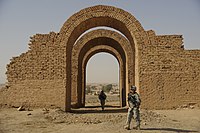Christianity of the Church of the East
| Church of the East | |
|---|---|
| Syriac: ܥܕܬܐ ܕܡܕܢܚܐ | |

Ruins of the ancient city and see of Assur.
|
|
| Classification | Eastern Christian |
| Orientation | Syriac Christian |
| Theology | Nestorianism |
| Head | Catholicos-Patriarchs of the East |
| Region | Middle East, South India, Far East |
| Liturgy | East Syrian Rite |
| Headquarters | Assur (Ottoman Empire) |
| Founder | Archbishop Nestorius |
| Origin |
Nestorian Schism (431–544) Sasanian Empire |
| Merged into | Catholic Church (1552), as the Church of Assyria and Mosul |
| Other name(s) | Nestorian Church |
The Church of the East (Syriac: ܥܕܬܐ ܕܡܕܢܚܐ Ēdṯāʾ d-Maḏenḥā), also known as the Nestorian Church, was an Eastern Christian church in the Sasanian Empire, with extensive influence throughout Asia. Employing the East Syrian Rite, by heritage it was part of Syriac Christianity.
The background of the establishment of the Church of the East is considered to be the first and third centuries among the early Assyrian Christian communities in the Parthian Empire's province of Mesopotamia, the Sasanian province of Asōristān, and the small independent kingdoms of Osroene, Adiabene, Beth Garmai, Beth Nuhadra and Assur.
The Church of the East was headed by the Patriarch of the East, continuing a line that, according to tradition, stretched back to the Apostolic Age. Liturgically, the church adhered to the East Syrian Rite, and theologically, it adopted the doctrine of Nestorianism, which emphasises the separateness of the divine and human natures of Jesus. This doctrine and its namesake, Nestorius (386–451), were condemned by the Council of Ephesus in 431, leading to the Nestorian Schism and a subsequent exodus of Nestorius' supporters to Sasanian Persia. The existing Christians in Persia welcomed these refugees and gradually adopted Nestorian doctrine by the 5th century, leading the Church of Persia to be known alternately as the Nestorian Church.
...
Wikipedia
